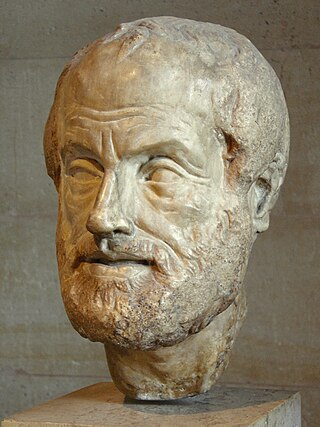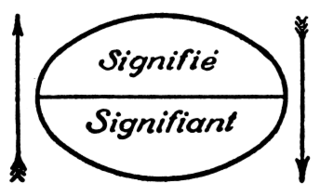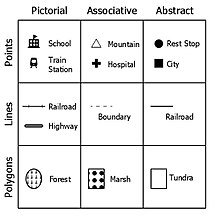An ideogram or ideograph is a symbol that represents an idea or concept independent of any particular language. Some ideograms are more arbitrary than others: some are only meaningful assuming preexisting familiarity with some convention; others more directly resemble their signifieds. Ideograms that represent physical objects by visually resembling them are called pictograms.

A sign is an object, quality, event, or entity whose presence or occurrence indicates the probable presence or occurrence of something else. A natural sign bears a causal relation to its object—for instance, thunder is a sign of storm, or medical symptoms a sign of disease. A conventional sign signifies by agreement, as a full stop signifies the end of a sentence; similarly the words and expressions of a language, as well as bodily gestures, can be regarded as signs, expressing particular meanings. The physical objects most commonly referred to as signs generally inform or instruct using written text, symbols, pictures or a combination of these.
Semiotics is the systematic study of sign processes and the communication of meaning. In semiotics, a sign is defined as anything that communicates intentional and unintentional meaning or feelings to the sign's interpreter.
In semiotics, a sign is anything that communicates a meaning that is not the sign itself to the interpreter of the sign. The meaning can be intentional, as when a word is uttered with a specific meaning, or unintentional, as when a symptom is taken as a sign of a particular medical condition. Signs can communicate through any of the senses, visual, auditory, tactile, olfactory, or taste.

Visual communication is the use of visual elements to convey ideas and information which include signs, typography, drawing, graphic design, illustration, industrial design, advertising, animation, and electronic resources. Visual communication has been proven to be unique when compared to other verbal or written languages because of its more abstract structure. It stands out for its uniqueness, as the interpretation of signs varies on the viewer's field of experience. The interpretation of imagery is often compared to the set alphabets and words used in oral or written languages. Another point of difference found by scholars is that, though written or verbal languages are taught, sight does not have to be learned and therefore people of sight may lack awareness of visual communication and its influence in their everyday life. Many of the visual elements listed above are forms of visual communication that humans have been using since prehistoric times. Within modern culture, there are several types of characteristics when it comes to visual elements, they consist of objects, models, graphs, diagrams, maps, and photographs. Outside the different types of characteristics and elements, there are seven components of visual communication: color, shape, tones, texture, figure-ground, balance, and hierarchy.
A referent is a person or thing to which a name – a linguistic expression or other symbol – refers. For example, in the sentence Mary saw me, the referent of the word Mary is the particular person called Mary who is being spoken of, while the referent of the word me is the person uttering the sentence.
In semiotics, the value of a sign depends on its position and relations in the system of signification and upon the particular codes being used.
In semiotics, a modality is a particular way in which information is to be encoded for presentation to humans, i.e. to the type of sign and to the status of reality ascribed to or claimed by a sign, text, or genre. It is more closely associated with the semiotics of Charles Peirce (1839–1914) than Ferdinand de Saussure (1857–1913) because meaning is conceived as an effect of a set of signs. In the Peircean model, a reference is made to an object when the sign is interpreted recursively by another sign, a conception of meaning that does in fact imply a classification of sign types.
In semiotics, denotation is the surface or the literal meaning, the definition most likely to appear in a dictionary.
In semiotics, connotation arises when the denotative relationship between a signifier and its signified is inadequate to serve the needs of the community. A second level of meanings is termed connotative. These meanings are not objective representations of the thing, but new usages produced by the language group.

Representation is the use of signs that stand in for and take the place of something else. It is through representation that people organize the world and reality through the act of naming its elements. Signs are arranged in order to form semantic constructions and express relations.
The Symbolic is the order in the unconscious that gives rise to subjectivity and bridges intersubjectivity between two subjects; an example is Jacques Lacan's idea of desire as the desire of the Other, maintained by the Symbolic's subjectification of the Other into speech. In the later psychoanalytic theory of Lacan, it is linked by the sinthome to the Imaginary and the Real.

Charles Sanders Peirce began writing on semiotics, which he also called semeiotics, meaning the philosophical study of signs, in the 1860s, around the time that he devised his system of three categories. During the 20th century, the term "semiotics" was adopted to cover all tendencies of sign researches, including Ferdinand de Saussure's semiology, which began in linguistics as a completely separate tradition.
Social semiotics is a branch of the field of semiotics which investigates human signifying practices in specific social and cultural circumstances, and which tries to explain meaning-making as a social practice. Semiotics, as originally defined by Ferdinand de Saussure, is "the science of the life of signs in society". Social semiotics expands on Saussure's founding insights by exploring the implications of the fact that the "codes" of language and communication are formed by social processes. The crucial implication here is that meanings and semiotic systems are shaped by relations of power, and that as power shifts in society, our languages and other systems of socially accepted meanings can and do change.
Visual semiotics is a sub-domain of semiotics that analyses the way visual images communicate a message.
The semiotics of social networking discusses the images, symbols and signs used in systems that allow users to communicate and share experiences with each other. Examples of social networking systems include Facebook, Twitter and Instagram.
The semiotics of fashion is the study of fashion and how humans signify specific social and cultural positions through dress. Ferdinand de Saussure defined semiotics as "the science of the life of signs in society". Semiotics is the study of signs and just as we can interpret signs and construct meaning from text we can also construct meaning from visual images such as fashion. Fashion is a language of signs that non-verbally converse meanings about individuals and groups. It holds a symbolic and communicative role having the capacity to express one's unique style, identity, profession, social status, and gender or group affiliation.
The semiotics of dress is the study of design and customs associated with dress (clothing), as patterned to a kind of symbolism that has rules and norms. It describes how people use clothing and adornments to signify various cultural and societal positions.

In semiotics, signified and signifier are the two main components of a sign, where signified is what the sign represents or refers to, known as the "plane of content", and signifier which is the "plane of expression" or the observable aspects of the sign itself. The idea was first proposed in the work of Swiss linguist Ferdinand de Saussure, one of the two founders of semiotics.
In art, symbolic language is the use of characters or images to represent concepts and imagery to communicate meaning by displaying an accessible concept, the signifier, to represent a signified concept.








